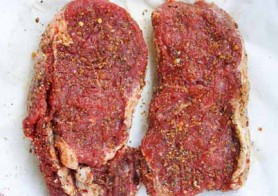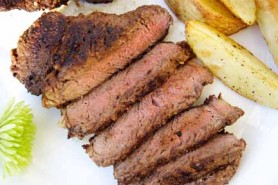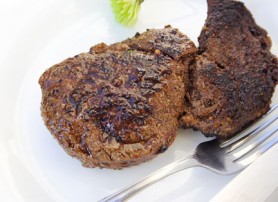Tastes Like Home
Hi Everyone,
What’s your steak preference – ribeye, strip, flank, sirloin, porterhouse, t-bone, prime rib…? And how do you like your steak – rare, medium rare, medium or well done? Ah, the choices when it comes to steak. For a steak novice, it can be a nerve-racking experience making these decisions and choices. And then there are those of us familiar with steaks that spend a lot of time trying to cook them properly.
Let’s start by facing some facts – a lot of Caribbean people don’t like their steak any other way than well done. The thought of pink or red meat is a major no-no. Secondly, though beef is sold in abundance in some countries, not all countries label the various cuts of meat. In some places your choices are exclusively bone-in or boneless; lean or with fat; stew beef, roast or stir-fry. If at the end of this column you are heading out to buy a couple of steaks, then do like I do, and suggest – take along a diagram of the animal with the parts clearly labelled and show it to your butcher, he or she will know exactly what you are referring to.

The thought of cooking a steak used to intimidate me. Actually, growing up I always thought of beef as this tough sort of meat and that the only way to break it down and make it edible was to cook it in a pressure cooker. Oh yeah, that would soften the heck out of it. And so, the only way that I’d eat beef was either stewed or in a curry. Steak was a treat I’d have when I’d travel overseas and dine at a steak house. Then one day, several years ago, while watching one of my favourite cooking shows, America’s Test Kitchen. I saw one of the chef’s cook a steak, on the stovetop, in a pan! Once the meat was rested and cut into, I could see how tender it was. I could not believe it. I had been depriving myself of homemade steak all this time when I could have just cooked it on my stove. Here was I thinking that I needed to have a grill, some super cooking skill and inside knowledge in order to make steak. Man, I hit the books and Internet to find out all I could about steaks and how to make it at home. Through the years there have been some expensive experiments that did not turn out well but there have also been some that went beyond my expectations.
Today, I am happy to report that I know the two cuts of steak I prefer, the ribeye and the strip, and I know how I like them, medium, which means the interior is pink to rosy brown. I cook my steak in a cast iron skillet on my stovetop or sometimes I start it off on the stove top in the skillet and then finish it off in the oven.
Given my newfound confidence these days in cooking steak, I thought I’d share some of what I’ve learnt with you. Hopefully, at the end of this column, you too will be cooking up some stellar steaks.
Cuts of Meat
Not all cuts of steak are created equal and a good steak starts with the right cut of beef. There are over eighteen different cuts of steak and many of them have more than one name depending on which part of the world you are from or live in. But let’s focus on the cuts most popular to us here in the Caribbean or that we hear of most often. Ribeye, as the name suggests is cut from the rib and is prized for its marbling (streaks of fat in the meat) which gives the steak extra flavour and tenderness. When cooked, it is juicy. Ribeye is one of the most popular and expensive cuts on the market. Strip is cut from the strip loin and consists of muscles that do little work and that is why it is particularly liked for grilling as the meat is tender, though not as tender as its neighbour, the ribeye. T-bone is so named because of the shape of the bone running through the steak. The bone separates the tenderloin section from the strip loin. Porterhouse is a large steak. Actually it is two steaks in one as it is a combination the Strip on one side and a Filet on the other. Given that it is a combination steak, many people believe it to be the best. Filet Mignon or Tenderloin is the most tender and choicest cut of steaks. Cut from the small end of the tenderloin this steak is the most expensive cut by weight.
Cooking Method

Tender cuts of steaks (mentioned above) work better with quick, dry cooking techniques such as grilling and sautéing or a combination of sautéing and then finishing off in a very hot oven. The tender cuts have a higher fat content and less muscle and fibre and will therefore cook up in no time.
When is a steak done? That depends on how you like your steak. The cooking time will vary depending on the cut of steak you are cooking, the size of the steak and the kind of heating source you are using – stovetop, grill, oven or a combination. Even the pan you are working with has an impact on your timing and temperature as some pans retain more heat than others. You’ll find that many recipes call for a cast-iron skillet for cooking steak on the stove top and that is because of it’s ability to retain heat and it’s flexibility to move easily from the stovetop to the oven.
So how do you like your steak? Before I go on, let me hasten to add that you should not let anyone browbeat you into how you should have your steak. I’ve read in many places where chefs frown on people who order their steaks well done as they feel that to cook the meat that way is to ruin it. Here’s what I say – who’s paying for it? My advice is to go with what you’re comfortable with. Personally, I don’t like my steak well done; I want the meat to be nicely pink to rosy brown not red and bloody.
Getting back to my question of how you like your steak, here’s something to guide you. If your steak is rare, the outsides are nicely browned but the inside would be blood red to dark pink. Medium-rare means that the interior will be pink; at medium, the insides would be pink to a rosy brown (that’s how I like mine) and well done, the interior will be brown to grey. Be patient with yourself as you work out how you would like to have your steak; no one knows your tolerance level better than you so test it. For example, I knew that there was no way I could eat my steak rare and so I never tried it that way. I worked my way from medium rare down to medium well and figured out that I preferred my steak to be medium.
With the two main components of cooking steak out of the way, here are some important pointers:
Always ensure that your meat is pat dry. I know Caribbean people are big into washing the freshest of meat, if you insist on doing so, then please pat the meat dry before seasoning it. I would suggest that you clean your meat by wiping it with damp paper towels.

An excellent piece of meat does not need to be dressed up too much, salt and freshly ground black pepper works great. If you are going to use a spice rub, be sure that it will be something that compliments the meat rather than smothers it. I have always found that a sprinkling of freshly ground cumin (geera) does wonders to beef.
Do not be afraid to season your meat for at least an hour before cooking, if you like; just be sure to pat dry any juices formed on top of the meat. If your meat was resting in the refrigeratror, bring it up to room temperature at least 30 minutes before cooking it.
Preheat your pan, grill and oven adequately before cooking your steak. Proper and adequate heat is needed for the meat to cook to the right internal temperature.
Do not, I repeat, do not poke, push and prod the meat once you’ve add it to the pan or grill. Leave it for the required time as specified by your recipe before moving it.
Once the steak it done, do not cut into it right away. Leave it to rest off of the heat for at least 10 minutes before cutting in to it. This is to allow the meat to absorb the juices that rushed to the surface during cooking. Failure to do this will result in a flavourless steak and when you cut into it, all the juices will run away.
When cutting the steak, slice against the grain of the meat; in other words, if the lines in the meat are running horizontal, then cut the meat vertically. Cutting on the bias is a nice touch as well. Cutting the meat opposite to how the grains are running makes the meat more tender to eat.
When cooking steak for company, be sure to ask them how they like their steak. Do not dictate for others.
I hope that I have armed you with some confidence to go out there and claim your steak!
Cynthia
[email protected]
www.tasteslikehome.org
Pan-Fried Steaks
Ingredients
2 (8oz) ribeye or strip steaks, 1 – 1 ¼” thick, pat dry
Salt and freshly ground black pepper to taste
1 tablespoon vegetable or canola oil
Equipment
1 cast iron skillet or heavy-bottomed skillet (or use an aluminium pan)
Paper towels
1 pr. tongs
1 plate
Method
1. Liberally season steaks on both sides with salt and pepper. Let rest for at least 10 minutes for some of the salt to be absorbed. Pat dry any juices that have formed on top of the steaks.
2. Add oil to pan and heat until very hot on medium high heat.
3. Add steaks to pan and let cook until browned, (5 minutes). Turn steak over and cook the other side for 3 minutes (for rare); 4 minutes for medium-rare or 5 minutes for medium. 6 minutes for well done.
4. Remove steak from pan and let rest for at least 10 minutes before cutting into it.
5. Serve whole or sliced with vegetables and a starch.
Note
You can season your steak with your favourite grill-steak seasoning or a sprinkling of ground geera (cumin)





